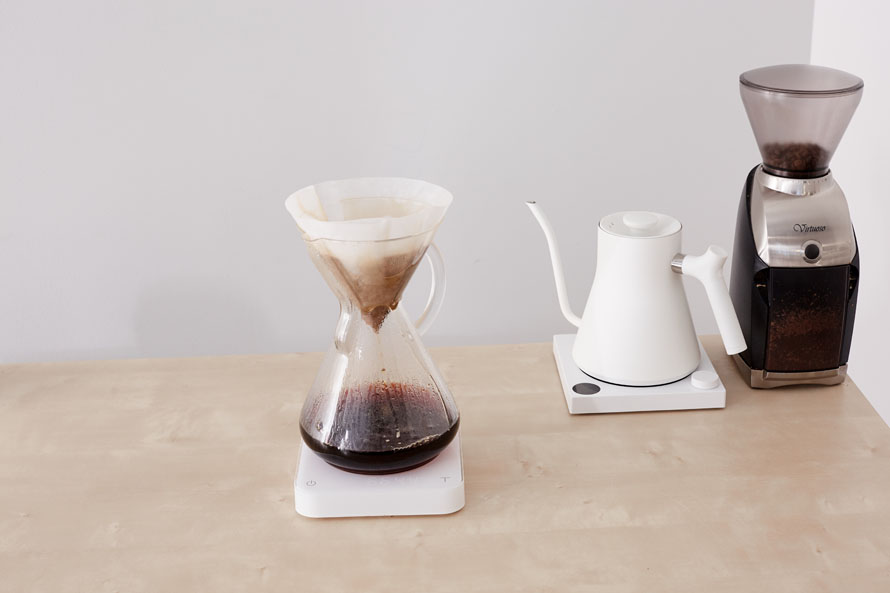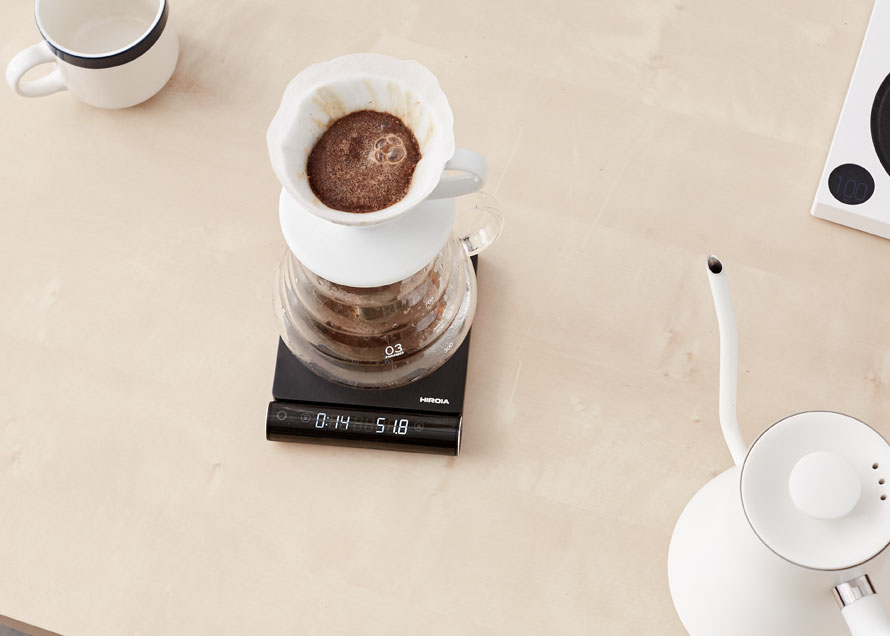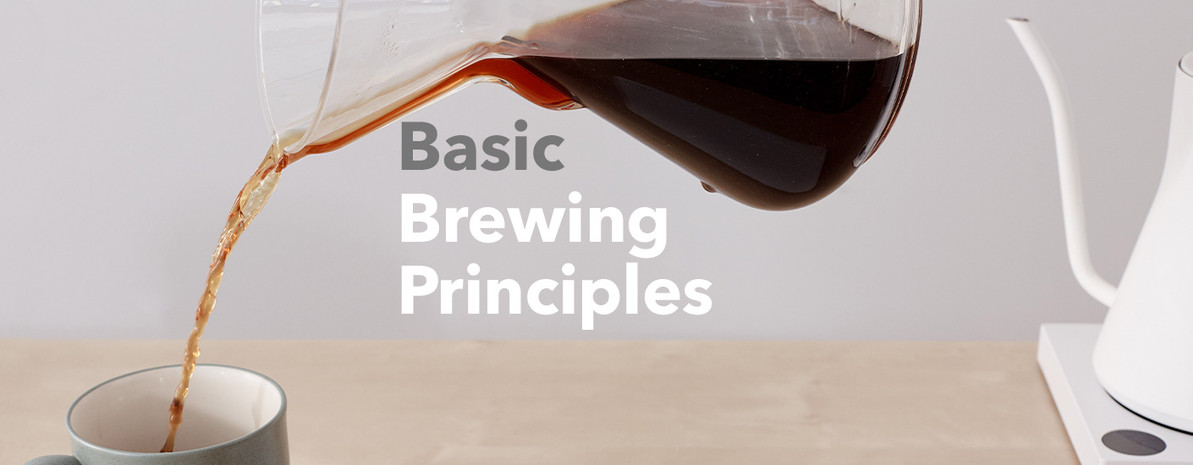Basic Coffee Brewing Principles
The basics of how to brew coffee at home. How to choose your coffee beans, use good water, and find the right recipe.
Before I got my first job as a barista I marveled at what seemed like alchemy going on behind the counter. The clinking of coffee beans being weighed into tins, the loud hum of the churning grinders, the steam rising from the tops of gleaming kettles, the repetitive patterns of water being poured over coffee grounds, all the while liquid gold was being transmuted into a warm mug just for me. I was smitten, hooked on the idea that coffee could be delicious, and committed to trying to understand which school of magic would unlock my ability to brew these fantastic elixirs at home. It wasn’t until some time into my coffee career that it clicked—coffee isn’t magic, it’s science and skill. Brewing delicious coffee is about using good ingredients well, learning which variables we control, and creating a repeatable process for ourselves. With a little time, a knack for experimentation, and these few helpful guidelines, you can learn to practice alchemy right in your own kitchen.

Use Good Coffee
It stands to reason that great brewed coffee starts with great whole bean coffee. Everyone will have different ideas about which coffees are delicious, but there are some guidelines we should all live by regardless of the sort of coffee we like.
• Fresh coffee is better. While roasted coffee is relatively shelf stable, it has a period of peak freshness for flavor. The time frame can vary, but the period of 5–21 days after the roast date will typically give you the best expression of flavor that the coffee beans have to offer. This peak freshness occurs between the time that the whole coffee beans have had enough time to offgas (the process of roasted coffee releasing excess CO2 and other gasses produced during roasting) and the time that the coffee begins to go stale due to oxidation and organic acid degradation.
• Freshly ground coffee is better, assuming that you have a good quality burr grinder at home. One of the greatest threats to delicious coffee is oxygen and oxidation (oxidation will make roasted coffee stale before it has the chance to live up to its full potential of becoming tasty brewed coffee), meaning that you only have a short window of time after grinding coffee to get the best out of your beans. The exception to this rule: if you don’t have a good burr grinder at home, you’ll get the best (and most consistent) results by having your local cafe or roaster grind it for you.
• Coffee that isn’t too dark or too light is better. Every coffee drinker will have varied preferences, and if you love coffee as dark or as light as you can find it I certainly won’t tell you that you’re wrong. However, coffee between those two extreme ends of the spectrum will be easier to brew and to get distinctive flavors out of, will have the most sweetness and balance naturally, and will have broader flavor diversity compared to roast levels too dark or too light.
Use Good Water
Brewed coffee quality is almost always more dependent on the water used for brewing than the coffee beans themselves. In fact, water makes up more than 98% of nearly every cup of drip coffee that you’ve ever had! While you can get pretty analytical about ensuring you have great brew water at home, there are a few basic requirements to be sure you address if you’re not ready to dive head first into the turbulent world of water for coffee.
• Be sure that your water is odorless and tasteless. Since water makes up such a significant portion of brewed coffee, any flavors or fragrances that are present in your water will be present in your brew.

• Be sure that your water isn’t too hard. Hard water will lead to bitter coffee almost every time. Making a small investment in a home filter like the Peak Water Pitcher Starter Pack will allow you to determine the hardness of your home water and filter it accordingly.
• Be sure that your water isn’t distilled or reverse osmosis. Water for brewing coffee actually requires some mineral content to extract flavor from the coffee grounds. Distilled or reverse osmosis (RO) water shouldn’t be used on their own, but can be a great base for mineral add-back products like Global Customized Water or Third Wave Water.
Use a Good Recipe
Good coffee rarely happens by accident, so if you’d like to drink well brewed coffee at home more than once in a great while you’ll need to get into the habit of using a regular recipe that works for you. Important variables that you’ll be able to adjust as you dial in your recipe include coffee dose, water volume, grind setting, brew temperature, and contact time. Eventually, as you learn more about those variables, you can make wise adjustments to your recipe on the fly in your pursuit of coffee nirvana.
• Start with known quantities. 2tbsp coffee per 6 fl oz, 1g coffee per 16g water, 60g coffee per liter, any of these ratios will give you a nice jumping off point depending on the measuring tools you have available to you. Measure every time for consistency.
• A scale is your best friend. Volumetric measurements (like tablespoons, fluid ounces, etc.) will get you in the ballpark when it comes to specificity, but your consistency will only get better when using mass measurements. It’s recommended that you use a scale, as specific as 0.1g tolerance, to measure both your ground coffee and water amounts.

• Don’t forget about time and temperature. The amount of coffee beans, coarseness of your grind, and volume of water used to brew are all important variables certainly, but so are total brew time and water/slurry temperature. Your water temperature will greatly affect the rate of extraction (speed at which coffee flavor is brewed out of your grounds), and the total brew time can give you immediate feedback about how your brew went.
Use a Consistent Process
The best roasted coffee, pristine brewing water, and all the measuring tools you can collect won’t produce great coffee if you don’t work toward consistency in your brewing process. From big picture concepts like using a regular recipe to seemingly small details like using the same number of pouring stages to add your water to your brewer each time, every part of the process will have some effect on the outcome. Find a comfortable rhythm and stick to it while you learn.
• Identify what you control. This will vary some depending on the brewing method you use, but there will be a ton of details that you get to define while brewing coffee. Coffee and water dose, temperature, and grind setting are all obvious enough, but also consider details like how much water you add with each pour, how long do you let the ground coffee bloom after you add the first amount of water, how far above the brewer do you hold your kettle, and lots more.
• Change one variable at a time. As you experiment, the most efficient way to understand and control specifics in your brewing process is to adjust one variable at a time. Using this rule will help you understand and track the resulting outcome in relation to your one change instead of wondering which variable(s) caused the difference in your results.
Get Brewing!
Most importantly, brewing coffee is a hands-on skill best learned through practice, tasting, and trial and error. It will take a combination of practice and acquired knowledge to make educated guesses about your recipe, but everyone can become a top flight brewer with some interest, patience, and time.
Happy brewing, y’all.



